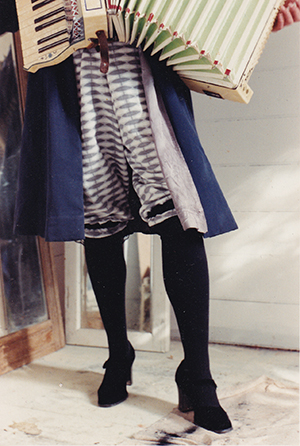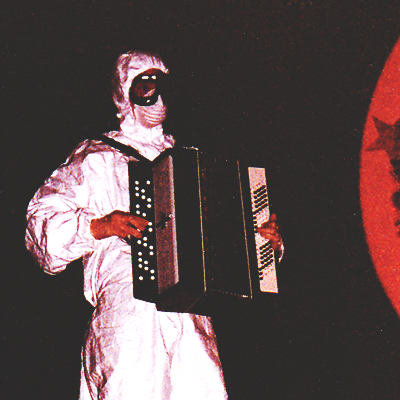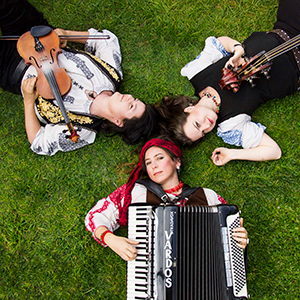
Accordion Attenzione
Vardos' Sofia Chapman on why the accordion deserves attention.
Numerous Europeans claimed to have invented the accordion. Where do we begin?
The accordion's earliest ancestor is said to be the Chinese Sheng, an instrument which you blow into a little like an ocarina, with vertical pipes.
In 1829 the Viennese instrument maker Cyrill Demian officially patented a hand bellow accordion. After Demian’s patent ended in 1834 the development of the accordions went wild.

By the end of the 19th century, the left-hand manual accordion had developed into a complex series of bass and preset chord buttons arranged according to the circle of 5ths. There were 6 rows of buttons: counter bass (a major 3rd above the fundamental), bass, major chord, minor chord, dominant 7th and lastly diminished 7th.
Poking Fun & Preconceptions
The accordion is often made fun of. There are many jokes at its expense. But why is the accordion often so maligned?
It is said a gentleman knows how to play the accordion but doesn’t. Fortunately, this doesn’t apply to women, which is why there are lots of female accordionists. There is also the perception in classical circles that usually it is failed pianists who switch to accordion.
Somehow I grew up without these prejudices.
Why does one take up a particular instrument? As a middle child perhaps I became used to harmonising with others in a large family.
Or is it the sound itself? The image of the instrument or the way in which tones are produced on it? The accordion was a revelation for me. After studying piano and embracing the sound through my body, I felt the reverberation in my core. It makes sense that the piano accordion is often called 'the stomach Steinway'.

Has accordion, will travel
For me it was also about being able to take your instrument with you. With touring and playing in different venues, I found there were lots of compromises with pianos, and you wouldn’t know what you would get. For a while I was dragging a missionary organ around Hobart where I grew up and first started performing, until I found the accordion.
'Is it merely escapism if one actually manages to escape?'
That’s what Vita Bellows, the protagonist of my award-winning play 'The Four Accordionists of the Apocalypse' says.
To the extreme
While it's not an extreme sport, the accordion has inspired some extreme activities around the world. People have jumped out of planes with them, built giant ones which are played by dozens of people, played them while skating, and more.
There is a physical side of playing the accordion focusing on ergonomics, stretches, modifications and practical advice for accordionists. Did you know that accordionists can’t really look at their left hand while playing? It's all done by touch. You can't look at your right hand too much either, as you will strain your neck.

There are also some modifications to one's life and wardrobe accordionists need to make. It’s not uncommon to get tears in clothing, as the bellows of the accordion can rip your garments to shreds. It’s useful to have a strong waistcoat or vest. Some might say a bulletproof vest, but then not everyone loves the accordion as we do.
European Histories
This style of accordion I play was developed in the northern Italian commune of Stradella and became known as the Stradella to differentiate itself from the many bass chord variant systems in circulation at the time. I've seen accordions with curved keyboards and two keyboards - like a harpsichord or organ where you have two manuals.
These days there can be up to five sets of reeds for each hand - combinations of which can be accessed through various register buttons, labelled, 'flute', 'piccolo', bassoon' and so on. They haven’t claimed to imitate piano yet.
My accordion also has something called the cassotto and although it may sound like an Italian dessert, it’s actually a secret chamber hidden deep inside which gives an extra rich resonance.
Personally, I prefer Italian models, but credit must go to the German company Hohner for the growth of the classical accordion. They wanted to publicise it not just as a folk instrument but an instrument that music could be composed for and which Hohner could produce and sell sheet music. A model accordion orchestra of around 30 skilled amateurs was put together in the late 1920s and toured extensively by bus through Germany and surrounds, presenting this new concept to the public. Hohner established a college for accordion teachers to raise the standard, and people went crazy for accordion. The first accordion compositions were commissioned, including solo and chamber works.
Accordion Activism
When the Nazis came to power, the accordion was frowned upon by the authorities as being a Jazz instrument and for its connection to African American musicians and dance music.
The president of the Reichsmusikkammer which controlled music in the Third Reich, announced:
'Now is the time to build a dam against the flooding of our musical life by the accordion.'
Dramatically, Hohner appealed to the government and managed to avert the elimination of the accordion. The free bass accordion is often known as the Classical Accordion - it allows more running around in the left hand and allows you to get the voicings you want. It is particularly useful for contrapuntal work but handy for any genre really. A converter button on the left manual switches the six row Stradella system mentioned above to the free bass system, thereby creating four and a half octaves of single notes.

I also have a Russian Bayan accordion in my collection which looks like a typewriter. It has three chromatic rows in a diminished pattern. The instrument dealer I bought it from in Hobart said it was sold to him by a visiting Russian sailor. My friend Zulya Kamalova looked at it, and from the papers (all instruments going in and out of Russia need to travel with papers) said that it was from a region near Chernobyl. I was a little worried, could it be radioactive? I’m not sure. I asked my physics teacher to run a Geiger counter over it as one does, and fortunately he gave it the all clear. It has some wonderful low notes but also its shortcomings. It has a beautiful flower patterned interior (or bellows), but no clip to hold the bellows shut.
I first visited Hungary and Romania in the late 20th century and have made seven trips there with Alana Hunt to study folk and Romany (Gypsy) music with musicians there. Especially in the early days there weren't a lot of good quality instruments in Romania. I would normally take a smaller accordion for travelling, usually a ladies' model Excelsior.
What I wanted to learn in Romania was the intricate ornamentation, the uneven rhythms and unusual scales and methods and variations of accompaniment which led to the virtuosic style exemplified by artists such as Constantin Fulgerica, Mexicanu, Viorel Fundament and others.

You can hear pieces from these composers at my next concert on Friday 22 September.
You might also be interested in
-
-
-
Explore the program notes in advance

